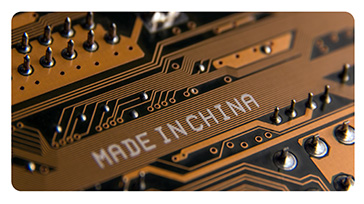The innovation programmes underpinning President Xi’s modernisation drive may see a shift towards public sector funding and nationally-strategic themes
China’s Communist Party Congress is over, but the dust is yet to settle. The day after this once-every-five-years event, the Hang Seng index fell to its lowest level since May 2009. Some of the biggest losers were, yet again, internet stocks such as Alibaba, Tencent and Meituan.
This is perhaps surprising, given that President Xi’s congress message was clearly one of deep support for technological innovation. Reference to this was made in his top three development objectives1 for the next decade, specifically:
- Significantly increase economic strength, scientific and technological capabilities
- Join the ranks of the world’s most innovative countries, with great self-reliance and strength in science and technology
- Build a modernised economy from a new pattern of development, basically achieve new industrialisation, informatisation, urbanisation and agricultural modernisation
In fact, a Reuters report2 found that the term “technology” was used 40 times in President Xi’s speech - up from just 17 times in his previous speech to the Party Congress back in 2017 – based around a central theme of “winning the battle” in core technologies. President Xi refers to this as “ke jiao xing guo”, that is “rejuvenating the country through science and education”.
China is still playing proprietary catch-up
In doing so, President Xi may have been mindful of the fact that, despite the substantial strides made by China in the area of technological advancements, there is more to be done. Looking at its wider innovation foundations. China is yet to catch up to several other major economies, and in particular the US.
Figure 1: Global Innovation Index 2022 rankings
| Economy | Income group | Overall rank | Income group rank |
| Switzerland | High Income | 1 | 1 |
| United States | High Income | 2 | 2 |
| Sweden | High Income | 3 | 3 |
| United Kingdom | High Income | 4 | 4 |
| Netherlands | High Income | 5 | 5 |
| Republic of Korea | High Income | 6 | 6 |
| Singapore | High Income | 7 | 7 |
| Germany | High Income | 8 | 8 |
| Finland | High Income | 9 | 9 |
| Denmark | High Income | 10 | 10 |
| China | Upper middle-income | 11 | 1 |
The World Intellectual Property Organisation’s Global Innovation Index (GII) captures the innovation ecosystem performance of 132 economies across a range of innovation metrics such as innovation investments, international patent filings, R&D expenditure, scientific publications and venture capital deals. The 2022 GII places China in eleventh place overall with Switzerland, United States and Sweden leading the pack.
But China ranks top within its upper middle-income group which includes Thailand and Malaysia. The GII report notes that China’s innovation performance is above expectation for its level of development and is the only middle-income economy within the GII Top 30. It is also ahead of many other developed and tech-driven economies such as France, Japan, Canada and Israel.
Scale alone is not enough
While China is still highly dependent on foreign-developed technologies, it has a large and growing middle-class population able to turn such technologies into a major growth driver. The country leads the world not just in terms of the absolute number of e-commence users – estimated at 780 million people – but also its e-commerce and mobile payments penetration rate. In 2020, nearly 25 percent of China’s retail sales of physical goods took place online, compared to just 18 percent globally3. Covid lockdowns will have further increased this number.
As a result, China hosts some of the world’s most prominent internet companies and some of the most exciting app features including real-time, location-based internet services and artificial intelligence-enabled algorithms. However, their appeal cannot counteract the regulatory and structural forces that have caused a slowdown in e-commerce growth and steep falls in internet stocks. The MSCI China Technology index, which has a high allocation to internet companies, was down by over 20 percent in 2021. Meanwhile, their billionaire founders are facing the brunt of the Chinese government’s “common prosperity” crackdowns.
Despite this, market analysts had been hoping for a change of heart. Liu He, widely thought to be the architect of many of China’s economic reforms, called for a more standardised and market-friendly approach to internet regulations in March 2022. Post the Communist Party Congress, the country’s economic team is expected to be overhauled and many previous economic advisors are now set to be replaced, including Liu He.
Innovations beyond e-commerce
Going forward, and in the absence of dissenting voices, it is likely that President Xi’s agenda of common prosperity and expansion of the middle class will continue. Analysts expect the introduction of a wide array of taxes, including stricter property and inheritance taxes, that are designed to support poorer households and bolster the social safety net. These will be at the expense of wealthier individuals and privately-owned monopolies.
We also expect China’s tech opportunities to extend well beyond online physical goods purchases. Both virtual and face-to-face services look likely to gain ground as middle-class disposable wealth increases and China’s population ages. These include sectors such as healthcare and tourism, where AI applications and automation have grown in recent years.
The country will also be aiming to double down on its strategic agricultural and industrial innovations. To date, China has the biggest electric vehicle (EV) market in the world, accounting for 53 percent of global sales in 2021. China also dominates the EV battery supply chain, a market that is projected to grow at a rate of 32 percent over the next eight years4 and where it has a distinct competitive advantage over the US and Europe.
The Chinese Academy of Agricultural Sciences (CAAS) has made significant progress in genome analysis, functional gene cloning and key breeding technologies for major livestock and poultry. This has enabled China to rank first in the world in terms of meat and egg production.
There has also been a significant surge in support for materials science. Currently, China has the greatest global output of more than 100 types of materials, including steel, non-ferrous metals, rare earth metals, cement, glass, chemical fibres, advanced energy storage materials, photovoltaic materials, and silicone. Based on this, the country’s new materials output is expected to rise from CNY7 trillion in 2021 to CNY 10 trillion in 20255.
Pivot towards self-sufficiency
In his congress speech, President Xi made no secret of his focus on the need to “build a completely new national-led system” in order to enable China’s self-reliance in the fields of science and technology.
While these plans have been in place for a considerable time, they have been hardened by recent US policy moves to limit China’s tech ascendency. This includes US sanctions against Huawei in 2018, the potential and actual delisting of Chinese companies on US stock exchanges (see UOBAM Research Note, 16 Mar 2022), and the CHIPS Act passed preventing recipients of US chip manufacturing subsidies from expanding in China (see UOBAM Research Note, 19 Aug 2022).
But it is the US’s advanced semiconductor export controls (see UOBAM Research Note, 19 Oct 2022) that is potentially the most damaging. Faced with the severity of these controls, China is increasing its state-led funding into STEM (Science, Technology, Engineering, Mathematics) fields. Shenzhen’s authorities have already announced subsidies of 20 percent of a chip manufacturer’s annual investment, up to US$1.4 million a year per applicant. On a broader level, China has adopted an ambitious “juguo tizhi” (whole-of-the-nation) system to accelerate their technological development. This will take the country from a market-driven to a national capital-driven model. Private and state-owned (SOE) companies deemed strategically important will likely benefit from this policy support.
References:
1Ministry of Foreign Affairs of the People’s Republic of China, “Full text of the report to the 20th National Congress of the Communist Party of China”, 25 Oct 2022
2Reuters, “Xi's call to win tech race points to new wave of Chinese state-led spending”, 17 Oct 2022
3Statista, “E-commerce in China”, 1 Feb 2022
4Precedence Research, “Electric Vehicle Battery Market Size to Hit US$ 559.87 Bn by 2030”
5Echemi, “By 2025, China’s New Materials Will Achieve 10 Trillion, The Absolute Explosion Of These Three Directions”, March 2022
This publication shall not be copied or disseminated, or relied upon by any person for whatever purpose. The information herein is given on a general basis without obligation and is strictly for information only. This publication is not an offer, solicitation, recommendation or advice to buy or sell any investment product, including any collective investment schemes or shares of companies mentioned within. Although every reasonable care has been taken to ensure the accuracy and objectivity of the information contained in this publication, UOB Asset Management Ltd (“UOBAM”) and its employees shall not be held liable for any error, inaccuracy and/or omission, howsoever caused, or for any decision or action taken based on views expressed or information in this publication. The information contained in this publication, including any data, projections and underlying assumptions are based upon certain assumptions, management forecasts and analysis of information available and reflects prevailing conditions and our views as of the date of this publication, all of which are subject to change at any time without notice. Please note that the graphs, charts, formulae or other devices set out or referred to in this document cannot, in and of itself, be used to determine and will not assist any person in deciding which investment product to buy or sell, or when to buy or sell an investment product. UOBAM does not warrant the accuracy, adequacy, timeliness or completeness of the information herein for any particular purpose, and expressly disclaims liability for any error, inaccuracy or omission. Any opinion, projection and other forward-looking statement regarding future events or performance of, including but not limited to, countries, markets or companies is not necessarily indicative of, and may differ from actual events or results. Nothing in this publication constitutes accounting, legal, regulatory, tax or other advice. The information herein has no regard to the specific objectives, financial situation and particular needs of any specific person. You may wish to seek advice from a professional or an independent financial adviser about the issues discussed herein or before investing in any investment or insurance product. Should you choose not to seek such advice, you should consider carefully whether the investment or insurance product in question is suitable for you.
UOB Asset Management Ltd. Company Reg. No. 198600120Z





